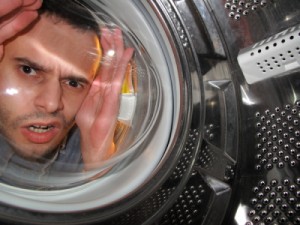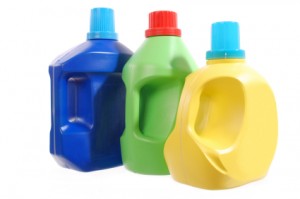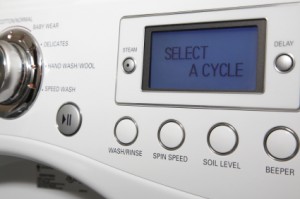There are a number of causes of mold odor in clothes washers.
- The most common cause of musty smell from your washing machine is overuse of detergents because the user is following directions for amount used. Generally speaking, we’re washing only perfume and sweat from our clothing so we don’t need much detergent. Unless washing soiled clothing, no more than 1 tbsp of any detergent should be used. This is especially important if using liquid detergent, if there is a water softener in the home or if using a municipal water supply. For HE washers it’s absolutely necessary to use HE detergent (low sudsing). Suds affect both the operation and longevity of all HE washing machines. A good test for detergent use is to fill your washer into a hot setting with no clothing (in the washer) and without adding detergent. Allow it to agitate for a couple of minutes. If the clothes washer suds’ you need to use less. If the soap suds are too much add just a half cap (1 tsp) of cooking oil and agitate for a couple of minutes then drain. Use this method to test detergent use in your dishwasher as well.
- Using fabic softener. Softener is dispensed in the rinse cycle and tends to collect on the inside of the plastic outer tub. The residue it leaves is a food source for mold and bacteria to grow in the dark moist environment of the clothes washer. We recommend switching to dryer sheets or dryer balls. Keep in mind that dryer sheets can also be overused and cause towels to be less absorbent and retain odor. The sheets can be cut in half or even thirds and work well. They can also be reused. There are a variety of expert opinions that both sheets and softener can cause contact dermatitis in more sensitive people and children. Dryer balls are another option but are not as popular because they don’t leave a scent or get rid of static cling as well in northern climates.
- Another cause for clothes washer smells is using mainly cold water for washing. Using mainly cold water for washing is understandable for saving energy but it makes preventive maintenance very important. Do your hottest wash or soak cycle as your last cycle on wash day or as preventive maintenance to dissolve residue. Ensure the water supply hoses to your washer are properly connected so the washer is getting hot washes and cold rinses when you want. This problem is more common than you may think!
*Bleach deteriorates rubber so replace your hoses if they come in contact with bleach for a length of time or after five years. This can save you many thousands of dollars in repair from water damage
- Another cause of washing machine odor is non-use of the appliance. If you are not going to use the washer for an extended period it’s a good idea to do a cleaning with a washing machine cleaner. If leaving for a vacation shut the supply hoses off in case of a hose break.
- Obstructions in drain pumps can cause mold odor by reducing the flow of water when draining. Almost all front load washers have a filter “trap” that is accessible to the owner. Rather than immediately calling for appliance repair service consult your owners manual for instructions on accessing this trap. ALWAYS UNPLUG YOUR MACHINE OR SHUT OFF THE CIRCUIT BREAKER BEFORE REPAIR and have several towels nearby when working on a drain pump because there is always 1-2 gallons of water left in all washers even after draining. It’s surprising what can make it through the washer and into the pump. Bra wires, toys, coins and screws are common items that can cause the pump to jam or catch lint to cause draining problems to make your washer smell. Go here for good instructions on cleaning the filter. Because top loaders don’t have filter traps object can jam the drain pump. These objects can sometimes be removed and the pump can be saved rather than buying a new pump.


